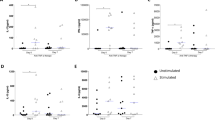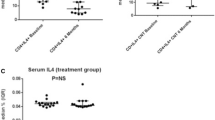Abstract
Narrow-band UVB (NB-UVB) therapy is widely used in the treatment of psoriasis; however, its precise mechanism is still unclear. To investigate the circulating CD4+ T-lymphocyte subpopulations in psoriasis patients before and after NB-UVB, thus providing new insights into the mechanism of NB-UVB in the treatment of psoriasis. We performed NB-UVB treatments for psoriasis patients (n = 30) and used flow cytometry, real-time PCR, and ELISA for the detection of circulating CD4+ T-lymphocyte subpopulations. The results were compared with healthy controls (n = 20) as well. We found increased circulating T helper 1 (Th1) and Th17 cell levels as well as decreased circulating regulatory T cells (Treg) levels compared to healthy controls. Additionally, there was a positive correlation between the percentage of circulating Th17 cells and Psoriasis Area and Severity Index (PASI) score. Furthermore, the percentage of circulating Th17 cells was negatively correlated with the Treg cells which led to an imbalance of Th17/Treg. NB-UVB therapy significantly reduced circulating Th1and Th17 cell levels while increasing Treg cell levels. These findings indicate that the overexpression of Th1 and Th17 cells together with the imbalance of Th17/Treg cells may play an important role in the pathogenesis of psoriasis. The mechanism of NB-UVB in the treatment of psoriasis may be through the inhibition of Th1 and Th17 cell immune response as well as the promotion of Treg cell immune response, thus ameliorating the disorder of circulating CD4+ T-lymphocyte subsets.




Similar content being viewed by others
References
Gulletta, E., Bottoni, U., & Foti, D. P. (2013). Psoriasis, a new challenge for laboratory medicine. Clinical Chemistry and Laboratory Medicine: CCLM/FESCC, 51, 1363–1368.
Mendoza, L. (2013). A virtual culture of CD4+ T lymphocytes. Bulletin of Mathematical Biology, 75, 1012–1029.
Romagnani, S. (2000). T-cell subsets (Th1 versus Th2). Annals of allergy, Asthma & Immunology: Official Publication of the American College of Allergy, Asthma, & Immunology, 85, 9–18; quiz 18, 21.
Kidd, P. (2003). Th1/Th2 balance: the hypothesis, its limitations, and implications for health and disease. Alternative Medicine Review: A Journal of Clinical Therapeutic, 8, 223–246.
Harrington, L. E., Hatton, R. D., Mangan, P. R., Turner, H., Murphy, T. L., Murphy, K. M., et al. (2005). Interleukin 17-producing CD4+ effector T cells develop via a lineage distinct from the T helper type 1 and 2 lineages. Nature Immunology, 6, 1123–1132.
Park, H., Li, Z., Yang, X. O., Chang, S. H., Nurieva, R., Wang, Y. H., et al. (2005). A distinct lineage of CD4 T cells regulates tissue inflammation by producing interleukin 17. Nature Immunology, 6, 1133–1141.
Fouser, L. A., Wright, J. F., Dunussi-Joannopoulos, K., & Collins, M. (2008). Th17 cytokines and their emerging roles in inflammation and autoimmunity. Immunological Reviews, 226, 87–102.
Kagami, S., Rizzo, H. L., Lee, J. J., Koguchi, Y., & Blauvelt, A. (2010). Circulating Th17, Th22, and Th1 cells are increased in psoriasis. The Journal of Investigative Dermatology, 130, 1373–1383.
Lowes, M. A., Kikuchi, T., Fuentes-Duculan, J., Cardinale, I., Zaba, L. C., Haider, A. S., et al. (2008). Psoriasis vulgaris lesions contain discrete populations of Th1 and Th17 T cells. The Journal of Investigative Dermatology, 128, 1207–1211.
Johansen, C., Usher, P. A., Kjellerup, R. B., Lundsgaard, D., Iversen, L., & Kragballe, K. (2009). Characterization of the interleukin-17 isoforms and receptors in lesional psoriatic skin. The British Journal of Dermatology, 160, 319–324.
Miyara, M., & Sakaguchi, S. (2007). Natural regulatory T cells: Mechanisms of suppression. Trends in Molecular Medicine, 13, 108–116.
Ohkura, N., Kitagawa, Y., & Sakaguchi, S. (2013). Development and maintenance of regulatory T cells. Immunity, 38, 414–423.
Noack, M., & Miossec, P. (2014). Th17 and regulatory T cell balance in autoimmune and inflammatory diseases. Autoimmunity Reviews, 13, 668–677.
Cai, Y., Fleming, C., & Yan, J. (2012). New insights of T cells in the pathogenesis of psoriasis. Cellular & Molecular Immunology, 9, 302–309.
Ozawa, M., Ferenczi, K., Kikuchi, T., Cardinale, I., Austin, L. M., Coven, T. R., et al. (1999). 312-nanometer ultraviolet B light (narrow-band UVB) induces apoptosis of T cells within psoriatic lesions. The Journal of Experimental Medicine, 189, 711–718.
Hamakawa, M., Sugihara, A., Okamoto, H., & Horio, T. (2006). Ultraviolet B radiation suppresses Langerhans cell migration in the dermis by down-regulation of alpha4 integrin. Photodermatology, Photoimmunology and Photomedicine, 22, 116–123.
Piskin, G., Tursen, U., Sylva-Steenland, R. M., Bos, J. D., & Teunissen, M. B. (2004). Clinical improvement in chronic plaque-type psoriasis lesions after narrow-band UVB therapy is accompanied by a decrease in the expression of IFN-gamma inducers—IL-12, IL-18 and IL-23. Experimental Dermatology, 13, 764–772.
Sigmundsdottir, H., Johnston, A., Gudjonsson, J. E., & Valdimarsson, H. (2005). Narrowband-UVB irradiation decreases the production of pro-inflammatory cytokines by stimulated T cells. Archives of Dermatological Research, 297, 39–42.
Walters, I. B., Ozawa, M., Cardinale, I., Gilleaudeau, P., Trepicchio, W. L., Bliss, J., et al. (2003). Narrowband (312-nm) UV-B suppresses interferon gamma and interleukin (IL) 12 and increases IL-4 transcripts: Differential regulation of cytokines at the single-cell level. Archives of Dermatology, 139, 155–161.
Racz, E., Prens, E. P., Kurek, D., Kant, M., de Ridder, D., Mourits, S., et al. (2011). Effective treatment of psoriasis with narrow-band UVB phototherapy is linked to suppression of the IFN and Th17 pathways. The Journal of Investigative Dermatology, 131, 1547–1558.
Johnson-Huang, L. M., Suarez-Farinas, M., Sullivan-Whalen, M., Gilleaudeau, P., Krueger, J. G., & Lowes, M. A. (2010). Effective narrow-band UVB radiation therapy suppresses the IL-23/IL-17 axis in normalized psoriasis plaques. The Journal of Investigative Dermatology, 130, 2654–2663.
Piskin, G., Koomen, C. W., Picavet, D., Bos, J. D., & Teunissen, M. B. (2003). Ultraviolet-B irradiation decreases IFN-gamma and increases IL-4 expression in psoriatic lesional skin in situ and in cultured dermal T cells derived from these lesions. Experimental Dermatology, 12, 172–180.
Shi, X., Jin, L., Dang, E., Chang, T., Feng, Z., Liu, Y., et al. (2011). IL-17A upregulates keratin 17 expression in keratinocytes through STAT1- and STAT3-dependent mechanisms. The Journal of Investigative Dermatology, 131, 2401–2408.
Jin, L., & Wang, G. (2014). Keratin 17: A Critical Player in the Pathogenesis of Psoriasis. Medicinal Research Reviews, 34, 438–454.
Chan, J. R., Blumenschein, W., Murphy, E., Diveu, C., Wiekowski, M., Abbondanzo, S., et al. (2006). IL-23 stimulates epidermal hyperplasia via TNF and IL-20R2-dependent mechanisms with implications for psoriasis pathogenesis. The Journal of Experimental Medicine, 203, 2577–2587.
Zhang, L., Yang, X. Q., Cheng, J., Hui, R. S., & Gao, T. W. (2010). Increased Th17 cells are accompanied by FoxP3(+) Treg cell accumulation and correlated with psoriasis disease severity. Clinical immunology, 135, 108–117.
Kondelkova, K., Vokurkova, D., Krejsek, J., Borska, L., Fiala, Z., Hamakova, K., et al. (2012). The number of immunoregulatory T cells is increased in patients with psoriasis after Goeckerman therapy. Acta medica, 55, 91–95.
Yun, W. J., Lee, D. W., Chang, S. E., Yoon, G. S., Huh, J. R., Won, C. H., et al. (2010). Role of CD4CD25FOXP3 regulatory T cells in psoriasis. Annals of Dermatology, 22, 397–403.
Bovenschen, H. J., van de Kerkhof, P. C., van Erp, P. E., Woestenenk, R., Joosten, I., & Koenen, H. J. (2011). Foxp3+ regulatory T cells of psoriasis patients easily differentiate into IL-17A-producing cells and are found in lesional skin. The Journal of Investigative Dermatology, 131, 1853–1860.
Singh, K., Gatzka, M., Peters, T., Borkner, L., Hainzl, A., Wang, H., et al. (2013). Reduced CD18 levels drive regulatory T cell conversion into Th17 cells in the CD18hypo PL/J mouse model of psoriasis. The Journal of Immunology, 190, 2544–2553.
Brazzelli, V., Barbagallo, T., Trevisan, V., Muzio, F., De Silvestri, A., & Borroni, G. (2008). The duration of clinical remission of photochemotherapy and narrow-band UV-B phototherapy in the treatment of psoriasis: A retrospective study. International Journal of Immunopathology and Pharmacology, 21, 481–484.
Furuhashi, T., Saito, C., Torii, K., Nishida, E., Yamazaki, S., & Morita, A. (2013). Photo(chemo)therapy reduces circulating Th17 cells and restores circulating regulatory T cells in psoriasis. PLoS ONE, 8, e54895.
Elghandour, T. M., Youssef Sel, S., Aly, D. G., Abd Elhameed, M. S., & Abdel Moneim, M. M. (2013). Effect of narrow band ultraviolet B therapy versus methotrexate on serum levels of interleukin-17 and interleukin-23 in Egyptian patients with severe psoriasis. Dermatology Research and Practice, 2013, 618269.
Eysteinsdottir, J. H., Sigurgeirsson, B., Olafsson, J. H., Fridriksson, T., Agnarsson, B. A., Daviethsson, S., et al. (2013). The role of Th17/Tc17 peripheral blood T cells in psoriasis and their positive therapeutic response. Scandinavian Journal of Immunology, 78, 529–537.
Li, J., Hou, R., Yang, Y., Liu, R., Zhao, X., Li, X., et al. (2013). Narrowband ultraviolet B interferes with gene expression in the peripheral blood T cells of patients with psoriasis. Dermatology, 226, 128–137.
Ekman, A. K., Sigurdardottir, G., Carlstrom, M., Kartul, N., Jenmalm, M. C., & Enerback, C. (2013). Systemically elevated Th1-, Th2- and Th17-associated chemokines in psoriasis vulgaris before and after ultraviolet B treatment. Acta Dermato-Venereologica, 93, 527–531.
Acknowledgments
We thank all members from the Department of Dermatology of Shanghai Tenth People’s Hospital for their advice and encouragement. We thank Andrew Armbruster for his editorial assistance. This work was supported in part by grants from National Science Foundation of China (81301356) (81360236), National Science Foundation of Shanghai (13ZR1432200), and the Science and Technology Commission of Shanghai Municipality Grant (134119b0700).
Author information
Authors and Affiliations
Corresponding author
Additional information
Xiuxiu Wang and Guanghua Wang have contributed equally to this study.
Rights and permissions
About this article
Cite this article
Wang, X., Wang, G., Gong, Y. et al. Disruption of Circulating CD4+ T-Lymphocyte Subpopulations in Psoriasis Patients is Ameliorated by Narrow-Band UVB Therapy. Cell Biochem Biophys 71, 499–507 (2015). https://doi.org/10.1007/s12013-014-0230-z
Published:
Issue Date:
DOI: https://doi.org/10.1007/s12013-014-0230-z




